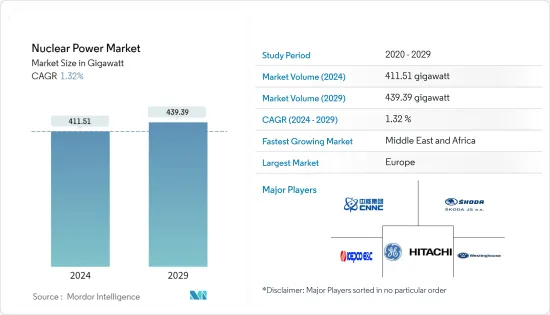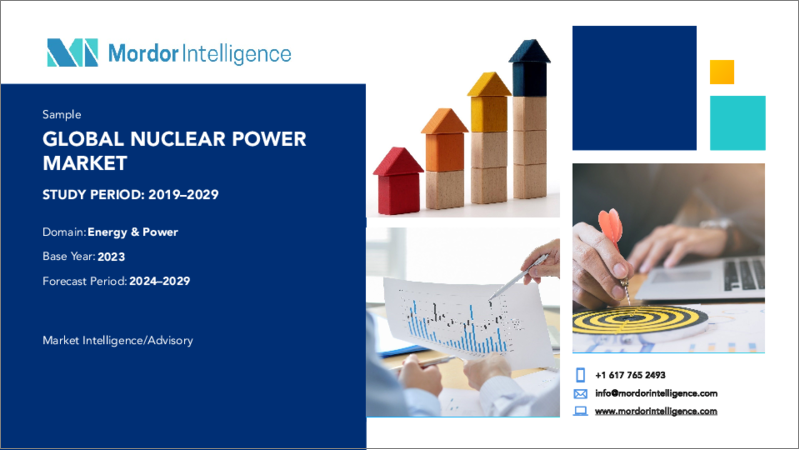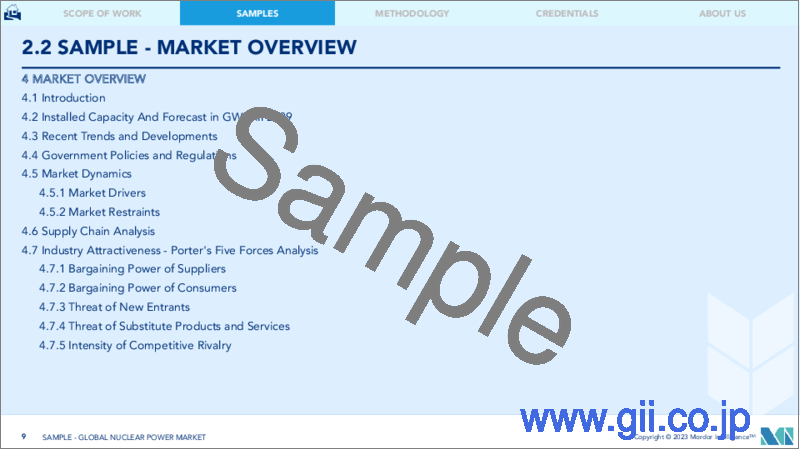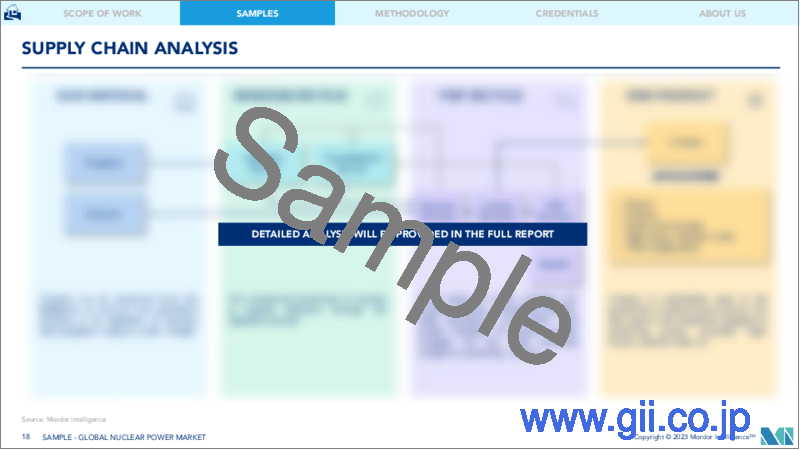|
|
市場調査レポート
商品コード
1439781
原子力発電:市場シェア分析、産業動向・統計、成長予測(2024年~2029年)Nuclear Power - Market Share Analysis, Industry Trends & Statistics, Growth Forecasts (2024 - 2029) |
||||||
|
● お客様のご希望に応じて、既存データの加工や未掲載情報(例:国別セグメント)の追加などの対応が可能です。 詳細はお問い合わせください。 |
|||||||
| 原子力発電:市場シェア分析、産業動向・統計、成長予測(2024年~2029年) |
|
出版日: 2024年02月15日
発行: Mordor Intelligence
ページ情報: 英文 120 Pages
納期: 2~3営業日
|
- 全表示
- 概要
- 目次
原子力発電市場規模は2024年に411.51ギガワットと推定され、2029年には439.39ギガワットに達し、予測期間中(2024-2029年)のCAGRは1.32%で成長すると予測されます。

COVID-19は2020年の市場にマイナスの影響を与えました。現在、市場は流行前の水準に達しています。
主なハイライト
- 化石燃料に比べて二酸化炭素排出量の少ない原子力発電が可能であることなどが、中期的な市場の成長を牽引しています。
- その一方で、原子力発電所を設置するための初期コストが高いことや、再生可能エネルギーなどの代替発電源が利用可能であることが、予測期間中の市場成長を抑制する可能性が高いです。
- とはいえ、世界各国は原子力エネルギーの安全性、技術的、経済的、環境的進歩を促進するため、第四世代原子力エネルギー技術の研究開発を進めています。その結果、同市場には将来的にいくつかのビジネスチャンスが生まれる可能性があります。
- アジア太平洋は、中国とインドにおける原子力エネルギーの大きなシェアにより、予測期間中に原子力発電市場で大きな成長が見られると予想されます。
原子力発電市場の動向
市場を独占すると予想されるエネルギー・セグメント
- 核エネルギーは、陽子と中性子の原子核または核心から放出されます。核エネルギーは、核分裂(原子の原子核がいくつかに分裂すること)または核融合(原子核が融合すること)によって生成されます。今日の世界では、核分裂は電力を生産し、核融合技術は研究開発(R&D)段階で電力を生産しています。2021年現在、世界の原子力発電量は、2020年の約2,553TWhに対し、約2,653TWhです。
- 人口と経済の増加は、世界の急速な都市化と相まって、今後数年間でエネルギー需要を大幅に増加させると予想されます。2020年の世界の一次エネルギー需要は556エクサジュール以上に達し、2010年の約505エクサジュールから10%増加します。国際エネルギー機関(IEA)によると、世界のエネルギー需要は2050年までに26%増加すると予想されています。発展途上国諸国により、世界の電力需要は倍増する可能性が高いです。
- 2022年10月現在、32カ国で約437基の商業用原子力発電所が稼働しています。米国は原子力発電能力が最も高いです。フランスの原子力発電能力は2番目に高いです。
- 今後数年間に原子力発電所への投資を計画している国もいくつかあります。例えば、中国は2021年11月、今後15年間で少なくとも150基の原子炉を新設する計画を発表しました。これは、世界のその他の地域が過去35年間に建設した数よりも多いです。この国の動きは、電力不足と停電のなかでのものでもあり、北京の前例のない決定をもたらしました。中国の新たな野心である原子力発電のコストは、約4,400億米ドルと見積もられています。中国核電総公司は、2035年までに原子力発電容量を大幅に拡大することを検討していると発表しました。
- インド政府もまた、大規模なインフラ開発計画の一環として、原子力発電能力の拡大に取り組んでいます。2021年12月、インド原子力省は、現在の原子力発電容量678万kWを2031年までに約2248万kWに拡大する計画を発表しました。さらに、インドのネットゼロ目標は、今後数年間、原子力を含むさまざまなクリーンエネルギーの組み合わせによって達成される可能性が高いです。
- 2022年2月、フランスは新たに6基の原子炉を開発し、さらに8基の原子炉を建設し、小型モジュール式原子炉の開発を推進する計画を発表しました。さらに、他にもいくつかの原子力発電所が世界的に建設または計画段階にあります。このような重要な原子力計画と投資シナリオは、今後数年間にわたって原子力発電市場の大幅な開拓をもたらすと思われます。
- したがって、上記の点から、予測期間中はエネルギー分野が原子力発電市場を独占すると予想されます。
著しい成長が期待されるアジア太平洋
- 原子力発電能力の伸びが長年にわたって限定的であった北米や欧州とは対照的に、アジア太平洋のいくつかの国では、クリーンな電力需要の増加に対応するため、原子力発電所の新設を計画・建設しています。
- 2021年現在、中国は世界で最も広範な原子力発電所の新設計画を持っています。この強力なプロジェクト・パイプラインは、中国の原子力発電市場の見通しを強化すると予想されます。この市場は、2011年の日本の福島原発事故後、計画の再審査が終了するまで原子炉の認可を停止するという政府の決定に起因する規制上の逆風に苦しんできました。
- 中国は原子力発電所の開発に最先端の技術と厳しい基準を用い、設計、建設、運転から廃炉に至るまで、原子力発電所のライフサイクル全体を厳格に管理しています。2022年10月現在、中国には稼働中の原子炉が54基あり、その合計容量は52.15GWeです。
- 中国の原子力部門は、予測期間中およびそれ以降も堅調なペースで拡大すると予想され、2018年から2027年にかけて容量は年率10.3%増加し、その結果、設置された原子力発電容量は95GWを超えることになります。これは、同国の発電を脱炭素化し、原子力の専門知識を蓄積して技術を輸出するという目的に沿ったものです。
- インド政府は、国内の電力需要の増加に対応するため、原子力発電能力の増強に力を注いでいます。インド政府によると、同国の原子力発電容量は2031年までに約22.5GWeに達する見込みです。
- 2022年5月現在、同国には運転可能な原子炉が22基(合計容量6.79GWe)あり、8基(合計容量6.02GWe)が建設段階にあります。
- 韓国は現在、電力の約4分の1を原子力発電でまかなっており、残りは輸入石炭とガスの混合でまかなっています。2022年9月現在、韓国には運転可能な原子炉が25基あり、その合計容量は2443万kWe、3基の原子炉の合計容量は420万kWe、2基の原子炉の合計容量は280万kWeで、それぞれ建設中、計画中、提案段階にあります。
- したがって、上記の要因により、アジア太平洋地域は予測期間中に大幅な市場成長を遂げると予想されます。
原子力産業の概要
原子力発電市場は適度に統合されています。市場の主要企業(順不同)には、GE-Hitachi Nuclear Energy Inc.、Westinghouse Electric Company LLC、KEPCO Engineering &Construction、SKODA JS AS、China National Nuclear Corporationなどがあります。
その他の特典:
- エクセル形式の市場予測(ME)シート
- 3ヶ月間のアナリストサポート
目次
第1章 イントロダクション
- 調査範囲
- 市場の定義
- 調査の前提
第2章 エグゼクティブサマリー
第3章 調査手法
第4章 市場概要
- イントロダクション
- 設置容量と2027年までの予測
- 最近の動向と展開
- 政府の規制と政策
- 市場力学
- 促進要因
- 抑制要因
- サプライチェーン分析
- ポーターのファイブフォース分析
- 供給企業の交渉力
- 消費者の交渉力
- 新規参入業者の脅威
- 代替品の脅威
- 競争企業間の敵対関係の強さ
第5章 市場セグメンテーション
- 用途別
- エネルギー
- 防衛
- その他の用途
- 原子炉タイプ別
- 加圧水型原子炉・加圧水型重水型原子炉
- 沸騰水型原子炉
- 高温ガス炉
- 液体金属高速増殖炉
- その他原子炉
- 地域別
- 北米
- 欧州
- アジア太平洋
- 南米
- 中東・アフリカ
第6章 競合情勢
- 合併、買収、合弁事業、提携、協定
- 主要企業の戦略
- 企業プロファイル
- Electricite de France SA(EDF)
- GE-Hitachi Nuclear Energy Inc.
- Westinghouse Electric Company LLC
- STP Nuclear Operating Company
- SKODA JS AS
- China National Nuclear Corporation
- Bilfinger SE
- BWX Technologies Inc.
- Doosan Heavy Industries & Construction Co. Ltd
- Mitsubishi Heavy Industries Ltd
- Bechtel Group Inc.
- Japan Atomic Power Co.
- Rosatom Corp.
第7章 市場機会と今後の動向
The Nuclear Power Market size is estimated at 411.51 gigawatt in 2024, and is expected to reach 439.39 gigawatt by 2029, growing at a CAGR of 1.32% during the forecast period (2024-2029).

COVID-19 negatively impacted the market in 2020. Presently the market has reached pre-pandemic levels.
Key Highlights
- Factors such as the ability of nuclear energy to generate electricity with lower carbon emissions compared to fossil fuels have been driving the market's growth over the medium term.
- On the other hand, the high initial cost of setting up a nuclear power plant and the availability of alternative power generation sources, such as renewable energy, is likely to restrain the market's growth during the forecast period.
- Nevertheless, nations worldwide are researching and developing generation IV nuclear energy technologies to promote safety, technical, economic, and environmental advancements in nuclear energy. This, in turn, is likely to create several future opportunities for the market.
- Asia-Pacific is expected to witness significant growth in the nuclear power market during the forecast period, owing to its substantial share of nuclear energy in China and India.
Nuclear Power Market Trends
Energy Segment Expected to Dominate the Market
- Nuclear energy is released from the nucleus or the core of an atom of protons and neutrons. Nuclear energy can be produced either in nuclear fission (when the nuclei of atoms split into several parts) or by fusion (when nuclei fuse). In today's world, nuclear fission produces electricity, while nuclear fusion technology produces power in the research & development (R&D) phase. As of 2021, the global nuclear power generation was about 2,653 TWh compared to around 2,553 TWh in 2020.
- The growing population and the economy, coupled with rapid urbanization globally, are expected to increase energy demand significantly in the coming years. The global primary energy demand in 2020 reached more than 556 exajoules, witnessing a 10% increase compared to about 505 exajoules in 2010. According to the International Energy Agency (IEA), global energy needs are expected to rise by 26% by 2050. The global electricity demand is likely to double due to emerging and developing economies.
- As of October 2022, about 437 commercial nuclear power plants were operating across 32 countries. The United States has the highest nuclear electricity generation capacity. France has the second-highest nuclear electricity generation capacity.
- Several countries have plans to invest in nuclear power plants over the coming years. For instance, in November 2021, China announced that it plans to build at least 150 new reactors in the next 15 years, which is more than the number made by the rest of the world in the last 35 years. The country's move also comes amid power shortages and blackouts, which have resulted in Beijing's unprecedented decision. The cost of the new nuclear ambition of China has been estimated to be around USD 440 billion. The China General Nuclear Power Corporation announced that it was looking to expand its nuclear capacity significantly by 2035.
- The Indian government is also committed to expand its nuclear power capacity as part of its massive infrastructure development program. In December 2021, India's Department of Atomic Energy announced plans to expand the current nuclear power capacity of 6.78 GW to about 22.480 GW by 2031. Additionally, the net-zero targets in India are likely to be met through a combination of various clean energy sources, including nuclear power, over the coming years.
- In February 2022, France announced plans to develop six new nuclear power reactors, building a further eight, and push ahead with the development of small modular reactors to reduce the country's energy demand while increasing its carbon-free energy capacity. Moreover, several other nuclear power plants are in the construction or planning phase globally. Such significant nuclear plans and investment scenarios are likely to result in substantial development of the nuclear power market over the coming years.
- Therefore, the energy segment is expected to dominate the nuclear power market during the forecast period due to the abovementioned points.
Asia-Pacific Expected to Witness Significant Growth
- In contrast to North America and Europe, where growth in nuclear electricity generating capacity has been limited for many years, several countries in the Asia-Pacific are planning and building new nuclear power plants to meet their increasing demand for clean electricity.
- As of 2021, China had the most extensive new-build program for nuclear energy globally. The strong project pipeline is expected to strengthen the outlook for the Chinese nuclear power market, which has previously suffered from regulatory headwinds stemming from the government's decision to suspend approvals for nuclear reactors until a re-examination of the plans was concluded after the 2011 Japanese Fukushima Disaster.
- China uses the most advanced technology and stringent standards for developing nuclear power plants and strictly manages the entire life cycle of nuclear power plants from design, construction, and operation to decommissioning. As of October 2022, China had 54 operating nuclear power reactors with a combined capacity of 52.15 GWe.
- The Chinese nuclear sector is expected to expand at a robust rate during the forecast period and beyond, with capacity increasing by 10.3% per year between 2018 and 2027, resulting in more than 95 GW of installed nuclear power capacity. This aligns with the aims of decarbonizing the country's electricity generation and amassing nuclear expertise to export technology.
- The Indian government is dedicated to increasing its nuclear power generation capacity to meet the growing electricity demand in the country. According to the Indian government, the country's nuclear capacity is expected to reach about 22.5 GWe by 2031.
- As of May 2022, the country had 22 operable nuclear reactors with a combined capacity of 6.79 GWe, and eight reactors with a combined capacity of 6.02 GWe are in the construction stage.
- South Korea currently generates about one-quarter of its electricity from nuclear power, with a mixture of imported coal and gas used to produce the balance. As of September 2022, the country had 25 operable nuclear reactors with a combined capacity of 24.43 GWe, three reactors with a combined capacity of 4.2 GWe, and two reactors with a combined capacity of 2.8 GWe were under construction, planned, and proposed stages, respectively.
- Therefore, owing to the above factors, Asia-Pacific is expected to witness significant market growth during the forecast period.
Nuclear Power Industry Overview
The nuclear power market is moderately consolidated. Some of the major players in the market (in no particular order) include GE-Hitachi Nuclear Energy Inc., Westinghouse Electric Company LLC, KEPCO Engineering & Construction, SKODA JS AS, and China National Nuclear Corporation, among others.
Additional Benefits:
- The market estimate (ME) sheet in Excel format
- 3 months of analyst support
TABLE OF CONTENTS
1 INTRODUCTION
- 1.1 Scope of the Study
- 1.2 Market Definition
- 1.3 Study Assumptions
2 EXECUTIVE SUMMARY
3 RESEARCH METHODOLOGY
4 MARKET OVERVIEW
- 4.1 Introduction
- 4.2 Installed Capacity and Forecast in GW Until 2027
- 4.3 Recent Trends and Developments
- 4.4 Government Policies and Regulations
- 4.5 Market Dynamics
- 4.5.1 Drivers
- 4.5.2 Restraints
- 4.6 Supply Chain Analysis
- 4.7 Porter's Five Forces Analysis
- 4.7.1 Bargaining Power of Suppliers
- 4.7.2 Bargaining Power of Consumers
- 4.7.3 Threat of New Entrants
- 4.7.4 Threat of Substitute Products and Services
- 4.7.5 Intensity of Competitive Rivalry
5 MARKET SEGMENTATION
- 5.1 By Application
- 5.1.1 Energy
- 5.1.2 Defense
- 5.1.3 Other Applications
- 5.2 By Reactor Type
- 5.2.1 Pressurized Water Reactor and Pressurized Heavy Water Reactor
- 5.2.2 Boiling Water Reactor
- 5.2.3 High-temperature Gas-cooled Reactor
- 5.2.4 Liquid-metal Fast-breeder Reactor
- 5.2.5 Others Reactor Types
- 5.3 By Geography
- 5.3.1 North America
- 5.3.2 Europe
- 5.3.3 Asia-Pacific
- 5.3.4 South America
- 5.3.5 Middle East and Africa
6 COMPETITIVE LANDSCAPE
- 6.1 Mergers, Acquisitions, Joint Ventures, Collaborations, and Agreements
- 6.2 Strategies Adopted by Leading Players
- 6.3 Company Profiles
- 6.3.1 Electricite de France SA (EDF)
- 6.3.2 GE-Hitachi Nuclear Energy Inc.
- 6.3.3 Westinghouse Electric Company LLC
- 6.3.4 STP Nuclear Operating Company
- 6.3.5 SKODA JS AS
- 6.3.6 China National Nuclear Corporation
- 6.3.7 Bilfinger SE
- 6.3.8 BWX Technologies Inc.
- 6.3.9 Doosan Heavy Industries & Construction Co. Ltd
- 6.3.10 Mitsubishi Heavy Industries Ltd
- 6.3.11 Bechtel Group Inc.
- 6.3.12 Japan Atomic Power Co.
- 6.3.13 Rosatom Corp.




